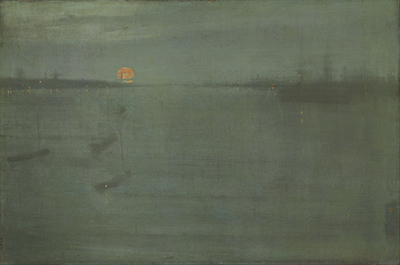When Whistler presented this piece of art for exhibition, he stated that art should appeal to the artistic sense of the eye and ear independent of all clap-trap. He was an unconventional painter who had spent most of his adult life in London and Paris.
The title of this painting is an example of how Whistler gave his paintings titles from music such as symphony, arrangement, and nocturne. The painting displays a hazy moonlight on an inlet in Southwest London. Whistler's aim was not to create a perfect replica image of the place, but to display subtle harmony of blue shades discontinued by gold touches. Whistler was motivated by the beautiful scene of the English Channel inlet since he knew the place quite well. The thought of making this painting featuring this inlet was probably backed up by his burning desire to explore limitations of paints and the aesthetic style. The specifics of the exact location are insignificant to the painting since his main idea during the preparation stage was to use less or no narrative overtones. He liked keeping everything simple from the preparation stage.
Whistler used Aesthetic Style which involved arranging colour and shapes on flattened surfaces. He was a daring artist that wanted to make sure his style was consistent and would be emulated by the next generation of artists. The technique used was unique from any other artist’s work. He used fainting colours and obscured objects in this painting. The great blend between his style and technique resulted to blurred and obscured shapes of distant images to form the primary focus of the Southampton waters. The painting was often ridiculed during exhibition. However, his brilliant nocturnal vision formed basis for abstract future experimentations of different styles in painting.
Whistler used oil on canvas as the media to articulate the 50.5cm by 76cm portrait. The portrait was painted in 1872 and has inscriptions of butterfly monogram signed on the lower right. Most of Whistler's work was not inspired by a specific person. He used imagination and knowledge to come up with unique titles and paintings. He was a daring pioneer who most of his work was an experiment of limitations and elasticity of paint. However, his aesthetic style of painting inspired many artists of the next century and they adopted it. The portrait originated in London and it is currently a property of Art Institute of Chicago.




